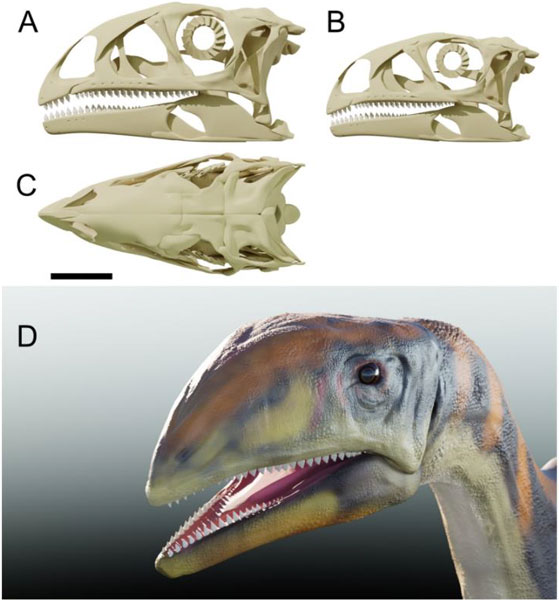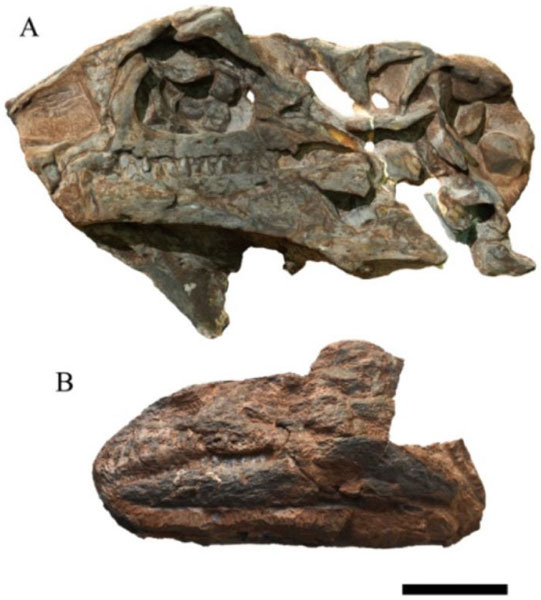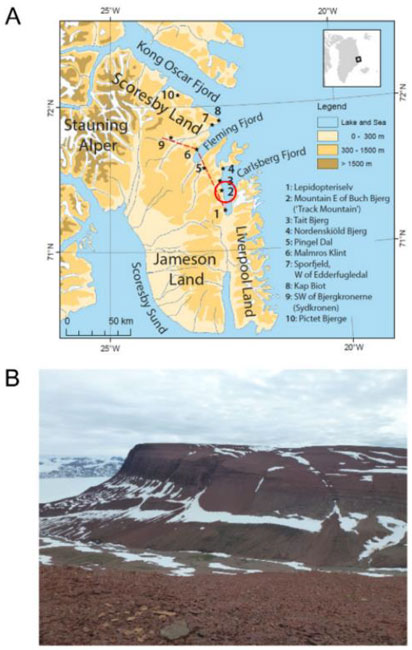This month has seen another new species of sauropodomorph named and described. Issi saaneq (pronounced is-y sa-ah-neq), roamed what is now eastern Greenland around 214 million years ago (Late Triassic), this new dinosaur has been named based on two fossil skulls believed to represent one juvenile and one older animal possibly a sub-adult. Ascribed to the Plateosauridae family and showing affinities to South American sauropodomorphs I. saaneq helps to extend our understanding of the evolution and development of these important early dinosaurs.

Originally Assigned to Plateosaurus
The skull fossils were found in the early 1990s, during excavations of sediments representing lake shore deposits that make up part of the of the Malmros Klint Formation in Jameson Land, Greenland. The larger skull was found in 1991, the smaller skull, now believed to represent the same species was found subsequently along with numerous other fossils including skull material that has yet to be catalogued and described.
The two skulls (specimen numbers NHMD 164741 and NHMD 164758), are now part of the vertebrate fossil collection of the Natural History Museum of Denmark. Postcranial material was also found in association with the smaller skull (NHMD 164758) and this could have come from the same animal, but these bones have also not yet been examined in detail.
When first found, it was thought that these fossils were examples of Plateosaurus (P. engelhardt which is now regarded as nomen dubium with fossil material assigned to P. trossingensis). As several new sauropodomorphs had been described in recent years, the researchers were able to tap into the wealth of new fossil data and confidently assign the skulls to a new genus.
Commenting on the significance of the find, lead author of the scientific paper, published in the journal “Diversity”, Doctor Victor Beccari (Universidade Nova de Lisboa), stated:
“The anatomy of the two skulls is unique in many respects, for example in the shape and proportions of the bones. These specimens certainly belong to a new species.”

“Cold Bone” – Issi saaneq
Issi saaneq is the first non-avian dinosaur to be named from fossils found in Greenland. The name comes from the local Inuit language, with “issi” meaning cold and “saaneq” meaning bone. This is a reference to the harsh and very unpleasant weather conditions associated with the fossil site. The bones of this dinosaur were cold to the touch and the field team were often “frozen to the bone” as they worked in the extremely chilly conditions.

Affinities with South American Sauropodomorphs as well as Plateosaurus
Phylogenetic assessment indicates that Issi saaneq has affinities to Brazilian plateosaurids such as Macrocollum (M. itaquii) and the European Plateosaurus, being recovered as the sister clade of Plateosaurus in this study. It is the northernmost record of a Late Triassic sauropodomorph.
To read Everything Dinosaur’s blog post about the naming and scientific description of Macrocollum itaquii: How Did Some Dinosaurs Get Long Necks?
The discovery of Issi saaneq expands the known geographical range of these dinosaurs and broadens our knowledge about the evolution of the Sauropodomorpha.
The scientific paper: “A New Sauropodomorph Dinosaur from the Late Triassic (Norian) of Jameson Land, Central East Greenland” by Victor Beccari, Octávio Mateus, Oliver Wings, Jesper Milàn and Lars B. Clemmensen published in Diversity.






Leave A Comment